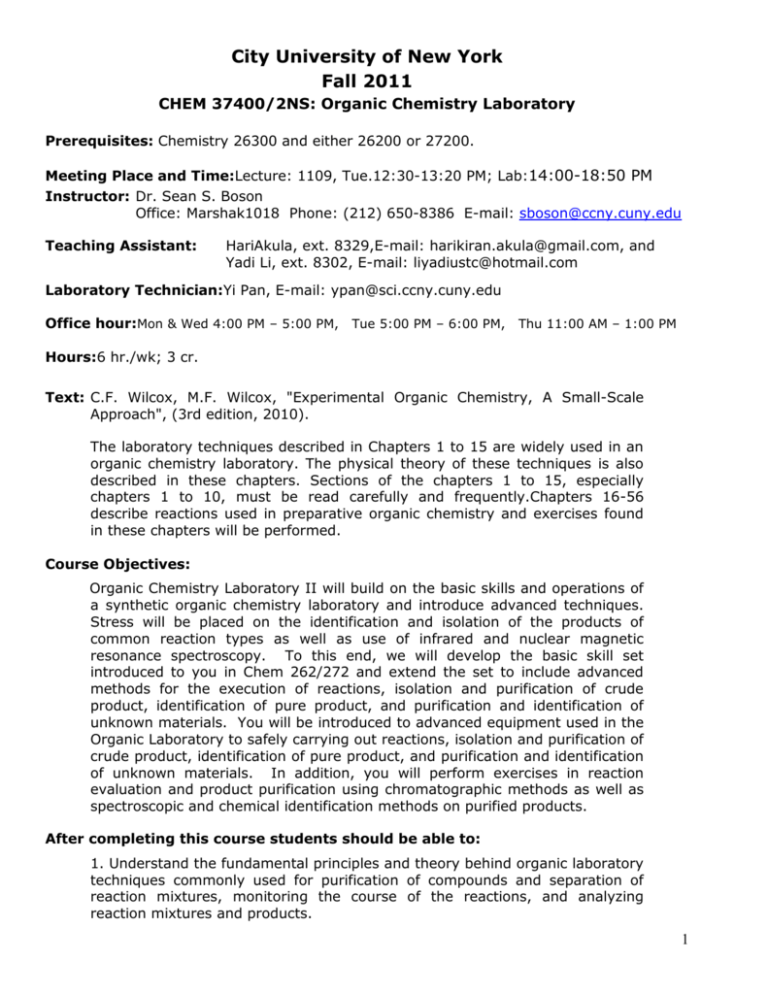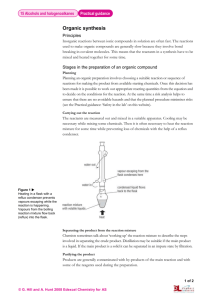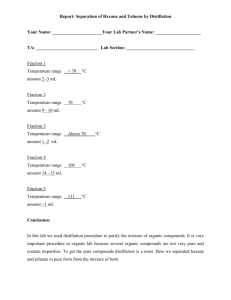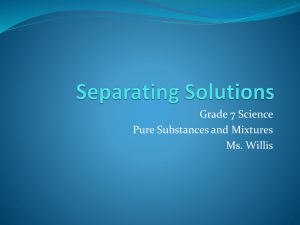The City College of New York, Department of Chemistry
advertisement

City University of New York Fall 2011 CHEM 37400/2NS: Organic Chemistry Laboratory Prerequisites: Chemistry 26300 and either 26200 or 27200. Meeting Place and Time:Lecture: 1109, Tue.12:30-13:20 PM; Lab:14:00-18:50 PM Instructor: Dr. Sean S. Boson Office: Marshak1018 Phone: (212) 650-8386 E-mail: sboson@ccny.cuny.edu Teaching Assistant: HariAkula, ext. 8329,E-mail: harikiran.akula@gmail.com, and Yadi Li, ext. 8302, E-mail: liyadiustc@hotmail.com Laboratory Technician:Yi Pan, E-mail: ypan@sci.ccny.cuny.edu Office hour:Mon & Wed 4:00 PM – 5:00 PM, Tue 5:00 PM – 6:00 PM, Thu 11:00 AM – 1:00 PM Hours:6 hr./wk; 3 cr. Text: C.F. Wilcox, M.F. Wilcox, "Experimental Organic Chemistry, A Small-Scale Approach", (3rd edition, 2010). The laboratory techniques described in Chapters 1 to 15 are widely used in an organic chemistry laboratory. The physical theory of these techniques is also described in these chapters. Sections of the chapters 1 to 15, especially chapters 1 to 10, must be read carefully and frequently.Chapters 16-56 describe reactions used in preparative organic chemistry and exercises found in these chapters will be performed. Course Objectives: Organic Chemistry Laboratory II will build on the basic skills and operations of a synthetic organic chemistry laboratory and introduce advanced techniques. Stress will be placed on the identification and isolation of the products of common reaction types as well as use of infrared and nuclear magnetic resonance spectroscopy. To this end, we will develop the basic skill set introduced to you in Chem 262/272 and extend the set to include advanced methods for the execution of reactions, isolation and purification of crude product, identification of pure product, and purification and identification of unknown materials. You will be introduced to advanced equipment used in the Organic Laboratory to safely carrying out reactions, isolation and purification of crude product, identification of pure product, and purification and identification of unknown materials. In addition, you will perform exercises in reaction evaluation and product purification using chromatographic methods as well as spectroscopic and chemical identification methods on purified products. After completing this course students should be able to: 1. Understand the fundamental principles and theory behind organic laboratory techniques commonly used for purification of compounds and separation of reaction mixtures, monitoring the course of the reactions, and analyzing reaction mixtures and products. 1 2. Use advanced techniques and equipment such as, vacuum distillation, soxhlet extraction, steam distillation, preparative TLC, HPLC, and GC to isolate and purify crude product and unknown materials. 3. Identify purified chemicals using spectroscopic methods (e.g. FT-IR, FTNMR, GC-MS). 4. Identify purified chemicals using chemical methods (e.g. reactive indicator tests such as Tollen's silver mirror, and derivative formation). 5. Perform organic reactions in different environments (e.g. air sensitive reagents, multi-step synthesis, solid-phase synthesis, and “green chemistry”). 6. Demonstrate proficiency in recording and evaluating experimental data including maintaining a proper laboratory notebook. 7. Write a proper laboratory report including abstract, experimental methods, results, discussion, and references. introduction, 8. Follow the safety requirements for an organic chemistry laboratory. 9. Access and utilize chemical information technology for proper experimental design and interpretation. 10. Apply ethical responsibilities and professional conduct in laboratory. Laboratory Exercises:4 preparative exercises and 3 technique exercises will be performed in this lab course. An exercise consists of one to many steps. It is expected that for each exercise a separate laboratory report is written. The Laboratory Report:You must prepare your laboratory reports in accordance with the following outline. Failure to do so will result in lost points and lower grades for the report. The laboratory report is subdivided into 6 sections, labeled as shown below. 1. Cover Sheet – Name, Section, Exercise Number 2. Theory, principle and objective 3. Main Reaction and Mechanisms, Physical Properties, all materials; Limiting Reagent; Theoretical Yield; Side Reactions and Mechanisms. 4. Separation Scheme, flow chart Procedure and lab. skills 5. Actual and Percentage Yields 1 2 3 4 6. Discussion 7. Conclusion t 0 3 6 4 4 4 4 25 Sections 1, 2, 3, and an outline of 4must be prepared at home, during the week preceding the first laboratory session for the new experiment. This preliminary laboratory report must be ready at the beginning of the lecture of the laboratory 2 session for that experiment. The outline of section 4 should be transcribed into your laboratory notebook. Section 4 and 5 must be completed in the laboratory. The completed laboratory report must be handed in on the last day assigned for the particular experiment. Failure to do so will result in a 10% point penalty for the report grade. The sections of the report are discussed in the textbook on pages 10 to 18, and pages 531 to 534 (Appendix D). Note that we require a slightly different sequence for the presentation of the sections than is described in the textbook; however, the textbook will provide valuable information and samples for you to follow in the proper preparation of the laboratory report. The preliminary laboratory reports: sections 1 -3shouldbe prepared on a word processor; you may hand-draw reaction mechanism. The final sections 4 and 5 will be hand written since they will be prepared in the laboratory. Complete sections 6 and 7 at home. The Laboratory Quizzes:The laboratory quizzes will test your knowledge of the theoretical basis of the exercises that are performed and will be conducted to evaluate your preparedness for the experiments. They will be drawn from all of the recommended reading, the theory of the experiments performed, and the techniques applied. The chapters which describe techniques especially relevant to each exercise are listed on the schedule with the exercise numbers. You are strongly advised to read the chapters in the textbook. Some techniques will be used more than once in the laboratory course. Make-up Sessions, Absences: Unless in an extraneous circumstance, nomake-up quizzes, or laboratory sessions, will be arranged. It is your responsibility to ensure that you attend all the laboratory sessions, on time. An absence from a laboratory without a suitable strong excuse will result in a score of zero being assigned. Final Examination: There will be no written final examination for Chem37400. Grading:The laboratory reports will account for 65% of the final grade, the quizzes during the semester (best 6 of 7quizzes) will provide 25%,and work skill in the lab accounts for 10%. Safety: All of the safety regulations that are outlined in chapter 1 must be adhered to. (Safety goggles will be worn at all times. Neither contact lenses, nor open-toe shoes are allowed in the lab). Any willful violation of our safety rules will result in the student’s immediate expulsion from the laboratory and the award of a laboratory grade of F. Breakages: You will be charged the replacement cost of any equipment which you break during the lab course. Some of our glassware is especially expensive and so you are urged to work carefully at all times. 3 Lecture: 1109: Tue.12:30-13:20; Lab: 1109: Tue. 14:00-18:50 TENTATIVE SCHEDULE OF EXPERIMENTS Week 1 Aug 30 Week 2 Sept 6 Week 3 Sept 13 Week 4 Sept 20 Week 5 Sept 27 Introduction, Lab Safety, Check In, Chemical Literature Search Review of Recrystallization, TLC, Melting Point and Boiling Point Measurements, FT-IR/ATR Training Separation of Cinnamaldehyde from Cinnamon Sticks via Steam Distillation and SoxhletExtraction and Synthesis of Cinnamaldehyde [Steam Distillation, Soxhlet Extraction] andcharacterization by IR, GC-MS and 1HNMR. Part I: Steam distillation or Part II: Soxhlet Extraction Separation of Cinnamaldehyde from Cinnamon Sticks via Steam Distillation and SoxhletExtraction and Synthesis of Cinnamaldehyde [Steam Distillation, Soxhlet Extraction] andcharacterization by IR, GC-MS and 1HNMR. Part I: Steam distillation or Part II: Soxhlet Extraction Separation of Cinnamaldehyde from Cinnamon Sticks via Steam Distillation and SoxhletExtraction and Synthesis of Cinnamaldehyde [Steam Distillation, Soxhlet Extraction] andcharacterization by IR, GC-MS and 1HNMR. - Handout - - Part III: Synthesis, IR, wrap-up. Week 6 Week 7 Oct 11 Oct 18 Week 8 Oct 25 Week 9 Nov 1 Week 10 Nov 8 Week 11 Nov 15 Separation of Cinnamaldehyde from Cinnamon Sticks via Steam Distillation and SoxhletExtraction and Synthesis of Cinnamaldehyde [Steam Distillation, Soxhlet Extraction] andcharacterization by IR, GC-MS and 1HNMR. Part IV: Synthesis, IR, GC-MS, and 1HNMR Analysis Isolation of [R]-[-]- and [S]-[+]-Carvone from Spearmint Oil and Caraway Seed Oil (Vacuum Distillation, LC Chromatography, GC-MS, TLC, and IR Spectroscopy) Part I: Vacuum Distillation or, Part II: Liquid Column Chromatography Isolation of [R]-[-]- and [S]-[+]-Carvone from Spearmint Oil and Caraway Seed Oil (Vacuum Distillation, LC Chromatography, GC-MS, TLC, and IR Spectroscopy) Part I: Vacuum Distillation, orPart II: Liquid Column Chromatography Identification of organic compounds in an unknown binary mixture. Part I: Separation and Purification Identification of an unknown binary mixture. Part II: Classification Test, Physical Properties, FT-IR-ATR Identification of organic compounds in an unknown binary mixture. Part III: Derivative Synthesis and 1HNMR Measurement Week 12 Nov 29 Handout Handout Handout Identification of organic compounds in an unknown binary mixture. Part IV: Melting Point Measurement, TLC, FT-IR-ATR, and Mass Spectroscopy Week 13 Dec6 Make-up week just in case… Otherwise Checkout Week 14 Dec 13 Check Out 4





